Scotland's Midwinter Fire Festivals
by Dr. Gareth Evans
Darkness comes early in the middle of a Scottish winter. At 60o
North in Shetland, the thin December sun struggles low in the sky
from its late 9am rise to its early set, just before 3pm. Even
along the comparatively southern coastline of the Moray Firth,
the day is only about 45 minutes longer. Small wonder then, that
these latitudes host some of the world's most spectacular
midwinter fire festivals, for perhaps nowhere else in the whole
of the British Isles is the summer sun more keenly missed, nor
its return more eagerly awaited.
Such midwinter fires have burned in communities along this
wind-swept northerly coastline throughout history, lit by
successive waves of Picts, Celts, Romans, Vikings and modern
Scots. Though today they are less widespread, those that remain
are truly remarkable spectacles.
The Fireball Ceremony, Stonehaven
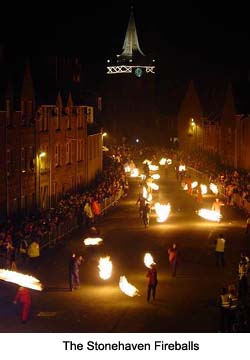 The
Aberdeenshire town of Stonehaven provides one of the wildest
welcomes to the New Year to be had at anywhere in Scotland. Each
year at midnight a group of fifty or more of the townsfolk parade
through the main streets to the accompaniment of pipes and drums,
whirling blazing fireballs around their heads by yard-long wire
handles, before finally hurling them into the sea at the harbour. The
Aberdeenshire town of Stonehaven provides one of the wildest
welcomes to the New Year to be had at anywhere in Scotland. Each
year at midnight a group of fifty or more of the townsfolk parade
through the main streets to the accompaniment of pipes and drums,
whirling blazing fireballs around their heads by yard-long wire
handles, before finally hurling them into the sea at the harbour.
The festival itself has been documented since 1910, though it is
possible to trace its direct origins to an earlier 19th Century
fishermen's celebration. It has, however, been suggested that
the ceremony probably dates back to much older pagan purification
rituals using fire to drive out evil spirits, or perhaps to chase
away the "ghost" of the old year. An alternative possibility is
that, like many other midwinter fires, this was originally a
solar celebration marking the start of the sun's return. While it
is impossible to say with certainty, there are distinct
similarities to both of these earlier customs and the whole event
has more than a little pagan feel to it, making it tempting to
believe that the modern festival might indeed be an echo of
pre-Christian rites. Whatever the truth of its own ancestry,
similar ceremonies have been recorded across Europe dating back
to at least the Middle Ages, despite attempts by various Synods
to outlaw such "barbarous heathenry" since the 8th
Century.
The fireballs are constructed from a double cage of stout wire
mesh, packed with a variety of combustible materials, typically
including coal, wood, paper, rags, fir cones and the like, though
the exact recipe comes down to the preference of each individual
swinger. The finished ball then has a strong handle made from a
double wrap of fencing wire firmly fixed to it, before it is
thoroughly inspected and certified safe for use.
The fireball swingers themselves make their appearance a short
time before the clock strikes midnight but the small pipe band is
usually on hand a little while earlier to entertain spectators.
Nowadays these may number ten or twelve thousand strong, but for
a time in the 1960s, with fewer and fewer swingers taking part,
the survival of the festival was uncertain. However, the efforts
of a few staunch local enthusiasts to revive this unique
celebration paid off and today the Stonehaven Fireball Ceremony
remains one of the most impressive spectacles of Hogmanay.
The Burning of the Clavie, Burghead
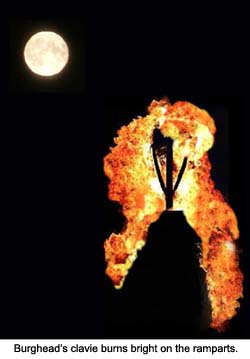 Seventy miles
north-north east of Stonehaven as the crow flies -- and eleven
days later -- the small village of Burghead on the Moray coast
hosts what is claimed as the oldest fire festival in Scotland and
said to be one of the most ancient in the world. Seventy miles
north-north east of Stonehaven as the crow flies -- and eleven
days later -- the small village of Burghead on the Moray coast
hosts what is claimed as the oldest fire festival in Scotland and
said to be one of the most ancient in the world.
In modern times the blazing clavie is an old whisky cask, but it
would once have been a herring barrel that was filled with wood
and daubed with tar, in keeping with this region of Scotland's
strong link with the sea. What might originally have been used is
open to debate.
It has been suggested that the word clavie may be derived
from the Gaelic cliabh, a wicker carrying basket, though
others propose the Latin clavus meaning a nail, since one
is used to fix the barrel to its carrying post, and traditionally
re-used from year to year. What is clear, is that the true
origins of the Burning of the Clavie, as befits the mythology of
so old a ceremony, have become lost in time, though the festival
has been variously claimed to be Pictish, Celtic, Roman or
Viking.
Today, the clavie is first set alight from a peat taken from the
fire of an old Burghead Provost, and then carried away by the
elected Clavie King. A squad of around ten men, usually
fishermen, take it in turns to carry the burning barrel around
the streets of Burghead, stopping from time to time at the doors
of eminent or favoured residents to offer a smouldering faggot to
bring them luck in the coming year. At the end of the
procession, the clavie is fixed on the ramparts of the old fort
on nearby Doorie Hill, more fuel is added and the resulting
beacon burns bright.
Whatever the real origins of the festival, the modern clavie
burning does offer some interesting historical insights. The
direction of the Clavie King's procession -- clockwise through
the streets -- hints at the same fundamentally solar nature
typical of midwinter fire festivals globally. Whoever first
instigated this celebration -- and the clavie burning has
similarities with all of the suggested pagan traditions -- their
simple fear that the sun would not be reborn and that light and
fertility would not return to the land is clearly evident. Old
superstitions die hard -- and perhaps no where more so than
amongst those who ply the sea for their livelihood. To this day,
fallen embers of the clavie will be snatched up, used to kindle a
New Year fire, kept for luck or sent to friends and relations who
have moved far away from Burghead.
The deliberate distribution of fragments from the ceremonial fire
to re-light hearths is a feature that the Burghead burning shares
with some other ancient, and now largely extinct, fire-festivals.
Despite the attempts of the Scottish church to outlaw the
observance of Celtic feasts, the open-air Beltane celebration --
an early summer fire-festival -- persisted in parts of the
highlands into the 18th and 19th centuries. One of the central
rituals was the kindling of need-fire -- a fire made
without the use of a tinderbox -- which was then used to light
the Beltane bonfires, embers of which subsequently being used to
relight the home-fires which had been allowed to go out the night
before. This idea of need-fire now remains in the midwinter
Burghead Clavie and at one time such festivals were common along
the north-east ports. While it has often been assumed that the
Scottish midwinter fire rituals are hangovers from Norse
tradition, it is equally possible that they represent the
transference of earlier Celtic celebrations to the New Year,
simply to fit in with the modern solar calendar.
A further and perhaps less contentious quirk of history surrounds
the timing. When Pope Gregory XIII issued the papal bull
Inter Gravissimas on 24 February 1582 that introduced the
Gregorian calendar to the world, events were set in motion that
were ultimately to result in Burghead's apparently anomalous New
year celebration. Contrary to what is sometimes suggested,
although in 1600 Scotland followed the Pope's new system in
making the first of January the official start of New Year
(previously 25th March) it was not until 1752 -- along with
England -- that the Gregorian calendar itself was adopted. By
this date, the error between the new dating system and the
earlier Julian model required eleven days to be dropped, thus
explaining why the "old" Scottish New Year, celebrated by the
burning of the clavie, has fallen on the 11th January ever
since.
Once almost certainly a small local event, and one repeated all
along the gale-lashed North Sea coastline, the Burning of the
Clavie at Burghead has grown into a much grander affair. Despite
being damned by the Presbyterian establishment as "idolatrous,
sinfule and heathenish" and officially banned in 1704, each
year large numbers of visitors join the inhabitants of Burghead
in celebration.
Up-Helly-Aa, Shetland
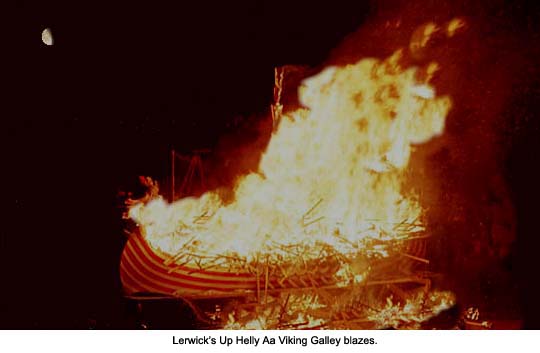
Possibly the best known of the Scottish midwinter fire festivals,
Shetland's Up-Helly-Aa, which takes place on the last Tuesday in
January each year, is also probably the most visually striking
and evocative, with a flaming longship and a horde of latter-day
Vikings at its core. Though a number of communities across this
group of islands -- which lie over 300 miles from Edinburgh and
about as far north as St Petersburg, Helsinki or Anchorage --
celebrate Up-Helly-Aa, the event in Lerwick, the islands'
administrative capital, is the largest and most elaborate.
The celebration is overseen by the Guizer Jarl -- to all intents
the King for the day, a different one being chosen each year --
with help from his squad of fifty or so heavily armed Norsemen.
Up to a thousand costumed "guizers" (the word derived from the
disguises they wear) each carrying a flaming torch, help drag the
boat through the streets to its ceremonial burning. Until the
introduction of the torchlight parade in Edinburgh, this
procession through Lerwick was claimed as the biggest of its kind
in Britain, if not the world -- and still remains one of the
oldest.
Once the ship has been escorted to the burning site, the climax
of the pageant sees the torches thrown aboard and several months
of work quite literally goes up in smoke. With the burning over,
in true Viking style, the focus of the evening shifts to feasting
and revelry, with eleven halls around the town hosting
Up-Helly-Aa parties. The company of guizers, now divided into
squads, visit these halls in rotation where they perform to
entertain the assembled revellers, which may involve parodying
local events, topical satire or a more traditional offering of
music and dance. Local tradition holds that each guizer must have
at least one dance before being permitted his next dram. It is a
festival which continues until well into the next day, which,
understandably, is a holiday in Lerwick.
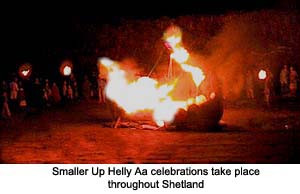 The Vikings arrived in Shetland a little over a
thousand years ago and although their presence is now long gone,
their influence remains on these islands, which at times still
seem more Scandinavian than typically Scottish. However, despite
this and the distinctly Dark Ages flavour of Up-Helly-Aa, the
festival probably owes its origins to rather more recent history. The Vikings arrived in Shetland a little over a
thousand years ago and although their presence is now long gone,
their influence remains on these islands, which at times still
seem more Scandinavian than typically Scottish. However, despite
this and the distinctly Dark Ages flavour of Up-Helly-Aa, the
festival probably owes its origins to rather more recent history.
While there does seem to be some evidence to suggest that rural
Shetlanders celebrated "Antonsmas" or "Up Helly Nacht"
twenty-four days after Christmas, there appears to be none which
points to a similar observance amongst the relatively urbanite
population of Lerwick. Festivities here seem to be only around
two-hundred years old, beginning after the end of the Napoleonic
Wars, with the return of soldiers and sailors complete with rowdy
habits and a liking of firearms.
At first, the revelry took place at Yule and New Year. A
Methodist clergyman visiting the islands described Lerwick's
Christmas eve of 1824 as "an uproar: from twelve of the clock
last night until late this night with blowing of horns, beating
of drums, firing of guns, shouting, bawling, fiddling, fifeing,
drinking and fighting. Thus was the state of the town all of the
night -- the street was as thronged with people as any fair I
ever saw in England."
The celebrations grew apace with Lerwick, until sometime in the
1840s, the rolling of burning tar barrels was introduced. As this
became more popular and the festivities ever more elaborate,
rival groups of tar-barrelers would often clash in the town's
narrow main street, this dirty and dangerous business leading to
many complaints from Lerwick's middle classes. Though the Town
Council attempted to control proceedings in response, it was not
until around 1870 that tar-barreling finally ceased.
At that time, changes implemented by a group of the town's young
men began the process of evolution for this post-Napoleonic riot
into the form of the modern festival. Borrowing from their rural
cousins' pagan history, they named it Up-Helly-Aa, moving it away
from Christmas towards the end of January, while introducing the
beginnings of costumed "guizing" and the torchlight procession,
both of which form central elements today. It seems that they
were also contemplating bringing a Viking theme to the new
festival but it was not until well into the 1880s that a longship
featured. The first Guizer Jarl made his appearance in 1906 and
it was not until shortly after the First World War that the squad
of Vikings became a regular part of the proceedings.
While Lerwick's festival cannot lay claim to the ancient pedigree
enjoyed by Burghhead or even, arguably, Stonehaven, it is
certainly one of the most spectacular fire-festivals anywhere in
the world, with a truly unique history all of its own and an
experience well worth having.
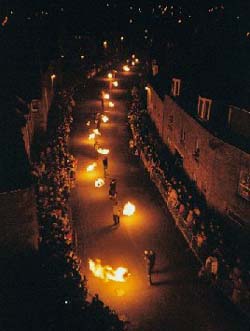
Locations and details:
Fireball Ceremony: Stonehaven, Aberdeenshire, 31st
December.
Stonehaven lies on the coast, beside the main A90
Dundee to Aberdeen road, just north of its junction with the A92
from Arbroath and about 12 miles south of Aberdeen city.
The organisers suggest being in the High Street around 11.15pm
(allow some extra time to park) to ensure a good view; they also
recommend wearing old clothes, for obvious reasons!
The Burning of the Clavie: Burghead, Moray, 11th
January.
Burghead is located on the Moray Firth between
Findhorn and Lossiemouth; access is by the B9013 off the main A96
Inverness to Aberdeen road, the turn off being approximately four
miles west of Elgin and eight miles east of Forres. Burghead is
also home to the remains of a fourth-century Roman Fort and may
even earlier have been the capital of the ancient Picts.
Up-Helly-Aa: Lerwick, Shetland Islands, last Tuesday in
January.
Shetland lies across 60oN -- approximately 100
miles off the north coast of Scotland. By air: From Edinburgh,
Glasgow, Inverness or Aberdeen - with connections available from
number of airports in Britain. Shetland's Sumburgh Airport is at
the island's southern tip, with buses hire cars and taxis
available for the trip to Lerwick, though pre-booking taxis and
cars is advised. By sea: NorthLink ferries operate regular
services from Aberdeen, while the Smyril Line sail from
destinations in Norway, Iceland, Denmark and Faroe.
The Flambeaux Procession: Comrie, Perthshire, 31st
December.
The small village of Comrie (not to be confused
with the one in Fife) is twenty miles west of Perth, on the A85
road to Loch Earn. As midnight chimes on the 31st December, a
small procession wends its way around the village before throwing
their fiery torches into the River Earn. It has been suggested
that this may have originated as a purification ritual. Nearby
attractions include the Deil's Cauldron waterfall and Lord
Melville's Monument.
The Biggar Bonfire:Biggar, South Lanarkshire, 31st
December.
Biggar lies on the A702, 10 miles north east of
junction 13 of the A74M and 25 miles south west of Edinburgh. For
many centuries the New Year has been ushered in with a huge
bonfire, lit by the oldest resident of the town, after a
torchlight procession.
More Information:
We regret that we no longer have the resources to maintain up-to-date links and/or hours and pricing details for the various sites and attractions listed on this website. For more information about the location(s) listed above, please use your favorite search engine or visit Wikipedia.
Gareth Evans is a freelance writer and photographer, having previously worked in the private sector before lecturing at the University of Durham. Having travelled extensively, he now concentrates on writing about subjects much closer to home -- both geographically and metaphorically. He is particularly interested in myths, legends and folklore, together with the often forgotten history of the Celtic lands, especially that of his own native Wales and Scotland, his adopted home. Gareth is currently planning his next book, looking at the role of the pagan Horned God in myth and history.
Article and photos © 2005 Gareth Evans
Stonehaven Fireballs photo courtesy of the Stonehaven Fireballs website.
|
